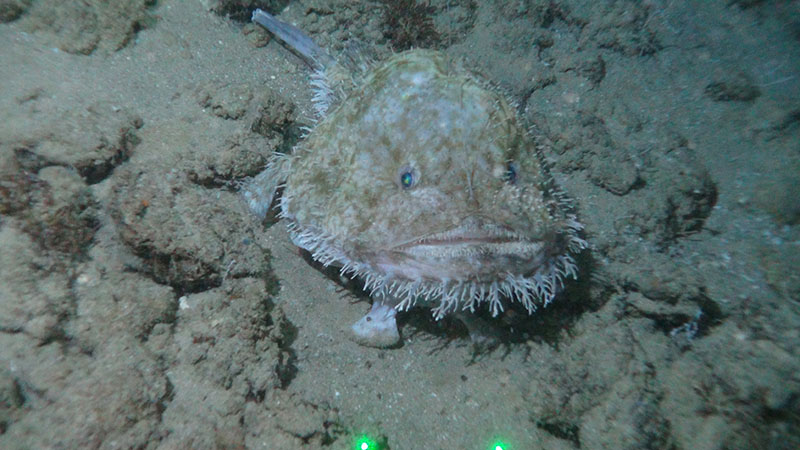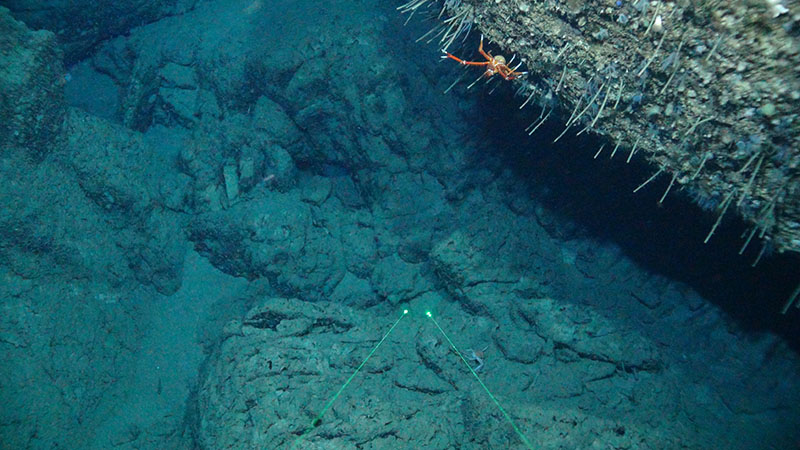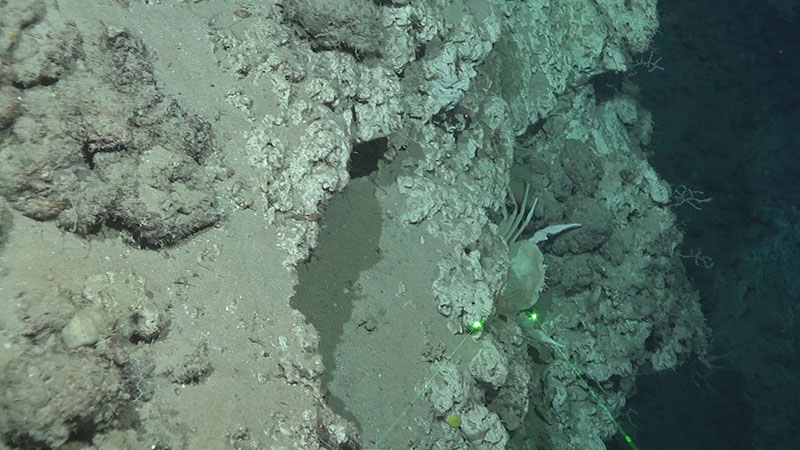
By John Gray, University of South Florida,
Peter Etnoyer, NOAA National Centers for Coastal Ocean Science
Heather Coleman, NOAA Deep Sea Coral Research and Technology Program
August 14, 2017

A goosefish (Lophiodes beroe) encountered on low relief hard bottom seafloor at 415 meters depth at Long Mound on the West Florida Shelf. Image courtesy of NOAA Southeast Deep Coral Initiative and Pelagic Research Services. Download larger version (jpg, 9.3 MB).
As yesterday’s mission log noted, our expedition is equipped with a science class remotely operated vehicle (ROV) capable of exploring the deep sea. Today’s ROV dive was spectacular due to favorable weather and oceanographic conditions, and especially due to the hard work of our mapping team and NOAA Ship Nancy Foster’s officers and crew.
Seafloor mapping is conducted on many scales and for multiple purposes. Deep-sea researchers have extensively surveyed regions of the West Florida slope between approximately 300-3,000 meters depth because it is more cost effective to collect high-resolution bathymetry data in deeper water than shallow water.

Map of a portion of the Southeast Deep Coral Initiative's August 2017 study site, including new high-resolution bathymetry data collected on the West Florida shelf (shallower than ~300 meters) using multibeam echosounders on NOAA Ship Nancy Foster. Mapping was conducted near a set of proposed Habitat Areas of Particular Concern (HAPCs, shown as boxed areas). Existing high-resolution mapping data, mostly covering the West Florida slope (deeper than ~300 meters), were obtained from the NOAA National Centers for Environmental Information (NCEI). Image courtesy of Matt Poti, NOAA National Centers for Coastal Ocean Science. Download larger version (jpg, 1.3 MB).
By combining past deep-sea coral observations with mapping efforts of NOAA’s fleet, our research team has a good idea of where to send the ROV Odysseus to look for coral and sponge habitat on the margin of the deep slope and shallow shelf. Exploring the unknown is one of the most exciting aspects of any mission. Images and video that we gather will help inform resource management as well as improve and calibrate NOAA’s predictive habitat models, which in turn guide future exploration.
Because the shallower seafloor directly adjacent to our study sites is only coarsely mapped, we are also collecting high-resolution bathymetry data at night when the ROV is not at work. This habitat information may aid fisheries managers when making future decisions.

Much of the seafloor of Long Mound is eroded carbonate that has been colonized by invertebrates such as tubeworms, leaving a pitted look. This image shows live (white) and dead (brown) Lophelia pertusa and Leiopathes glabberima (orange) coral attached to the carbonate rock with a roughy swimming by. Image courtesy of NOAA Southeast Deep Coral Initiative and Pelagic Research Services. Download larger version (jpg, 8.2 MB).
So back to the day’s spectacular dive – we chose to explore the Long Mound region, one of five potential habitat areas of particular concern (HAPCs) proposed by the Gulf of Mexico Fishery Management Council. These areas are part of the West Florida carbonate ledge system, and are under consideration for protection from bottom-contact fishing gear. All the areas we will be visiting are connected by this steep ‘scarp’ – a ribbon of geological intensity 270 kilometers long that supports diverse deep-sea communities.
The ROV Odysseus, operated by Pelagic Research Services, captured a set of more than 1,000 stunning images today. A few are included here with more to come soon!

A squat lobster hangs off the Long Mound carbonate ledge with a garden of tubeworms and a cup coral at 415 meters depth on the West Florida Shelf. Image courtesy of NOAA Southeast Deep Coral Initiative and Pelagic Research Services. Download larger version (jpg, 10.9 MB).

A section of carbonate ledge running through the target sites of discovery for the Southeast Deep Coral Initiative expedition. Invertebrates visible in the image include a golden crab (Chaceon fenneri) and juvenile sea fans. Laser dots are spaced 10 centimeters apart as a measurement reference Image courtesy of NOAA Southeast Deep Coral Initiative and Pelagic Research Services. Download larger version (jpg, 1.4 MB).
The expedition is supported by NOAA’s Deep Sea Coral Research and Technology Program through the Southeast Deep Coral Initiative (SEDCI), a multi-disciplinary effort that will study deep-sea coral ecosystems across the Southeast United States in 2016-2019.